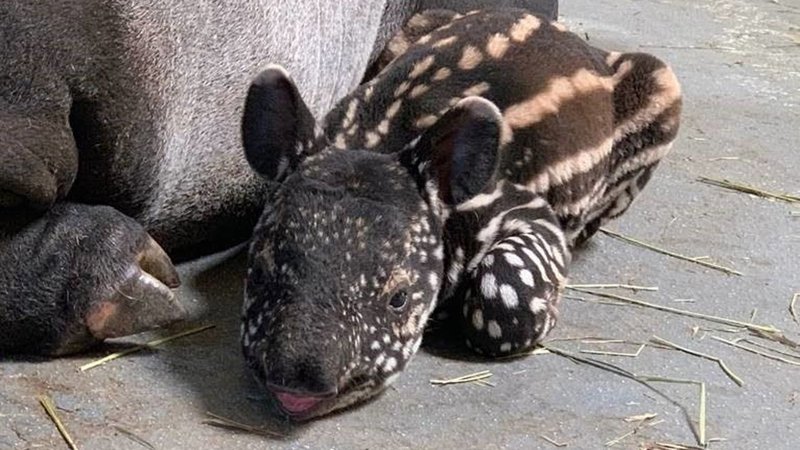
The Malayan tapir, with its distinctive black and white coloring, looks like a mix between an elephant and a hippopotamus. Native to the rainforests of Southeast Asia, these gentle herbivores have some surprising traits that suggest they might be smarter than you think. Let’s explore what makes them tick, from their problem-solving skills to their social interactions.
Understanding Malayan Tapirs: A Quick Overview
Before we get into their intelligence, it’s helpful to know a little about the Malayan tapir itself. These animals are the largest of the tapir species and can weigh up to 1,000 pounds! They have a unique body shape, with a rounded body, short legs, and a long snout that they use like a trunk. This physical structure helps them reach leaves and fruits high up in trees.
Malayan tapirs are nocturnal, meaning they’re most active at night. They tend to be solitary creatures, although they occasionally come together to mate or raise their young. Their lifestyle and social behavior can give us clues about their cognitive abilities—after all, understanding how they navigate their world is a key part of understanding their intelligence.
Tapirs and Their Environment
So, how do Malayan tapirs interact with their environment? Well, they are quite adept at finding food. These animals primarily eat leaves, fruits, and twigs. But they don’t just munch mindlessly; they exhibit selective feeding habits. Tapirs can identify ripe fruits and prefer certain types of vegetation over others.
Their keen sense of smell plays a huge role in this selective feeding. With a strong sense of smell, they can sniff out food sources from quite a distance. This ability shows us that tapirs have a knack for problem-solving, as they must constantly evaluate their surroundings to find the best meals available.
Problem-Solving Skills
When it comes to intelligence, problem-solving skills are often a major indicator. While we don’t have tapirs lining up for standardized tests, scientists have observed their behaviors that suggest they can think critically. For example, when faced with obstacles, tapirs show adaptability. They can easily navigate through dense forests or wade through water—both major aspects of their habitats.
You might wonder how this relates to their smartness. Well, think of it like this: if they encounter a fallen tree blocking their path, they won’t just stand there and wait. Instead, they’ll assess the situation and find a way around it. This ability to adapt and overcome challenges points to a level of cognitive functioning that is definitely noteworthy.
Social Behavior and Communication
While tapirs are generally solitary, they do have a variety of ways to communicate with one another. They use sounds, body language, and even scent markings to convey their feelings and intentions. For instance, when they feel threatened, a tapir may emit a series of low grunts to warn other tapirs in the area.
Interestingly, the ability to communicate with others is another mark of intelligence. Tapirs need to understand not only their own needs but also the needs of those around them. Their social interactions—though not as complex as those of elephants—do hint at a level of awareness and connection with their environment.
Learning and Memory
Learning and memory are crucial components of animal intelligence. In studies, tapirs have shown the ability to remember locations of food sources and other landmarks in their habitat. This memory helps them efficiently navigate their environment, ensuring they find food and avoid dangers.
For example, if a tapir has had a bad experience with a particular area—maybe due to the presence of a predator—they’re likely to remember this and avoid that spot in the future. This capacity to learn from experience and adapt behavior accordingly shows a level of cognitive development that’s quite impressive for an animal of their kind.
Comparative Intelligence: Tapirs vs. Other Animals
When comparing Malayan tapirs to other animals, it’s essential to set realistic expectations. They may not rival dolphins or chimpanzees in cognitive abilities, but they still have unique strengths. For instance, while apes may excel in tool use, tapirs have honed their survival skills in dense forests, showcasing a different kind of intelligence.
Let’s consider elephants, too. Both tapirs and elephants share some similar traits, such as strong social bonds and a capacity for memory. However, elephants might outshine tapirs in social complexity. Still, this doesn’t diminish the cleverness that tapirs have adapted to survive in their particular habitat.
Conservation and Understanding Intelligence
Understanding the intelligence and behavior of Malayan tapirs is crucial for their conservation. As their habitats are increasingly threatened by deforestation and human encroachment, knowing how smart they are can help in creating effective conservation strategies. By recognizing their needs and abilities, we can work toward ensuring their survival in the wild.
Efforts to conserve tapirs not only protect these animals but also the rich biodiversity of their rainforest habitats. The more we learn about tapirs, the better equipped we are to help them thrive in a changing world.
In conclusion, Malayan tapirs may not be the first animals that come to mind when we think about intelligence, but they possess unique cognitive abilities and behaviors that reflect their adaptability and survival skills. Their problem-solving capabilities, communication methods, and capacity for learning all point towards a richness in their intelligence that’s worth appreciating. The next time you spot one of these gentle giants, remember—there’s a lot more going on in that brain than meets the eye!

